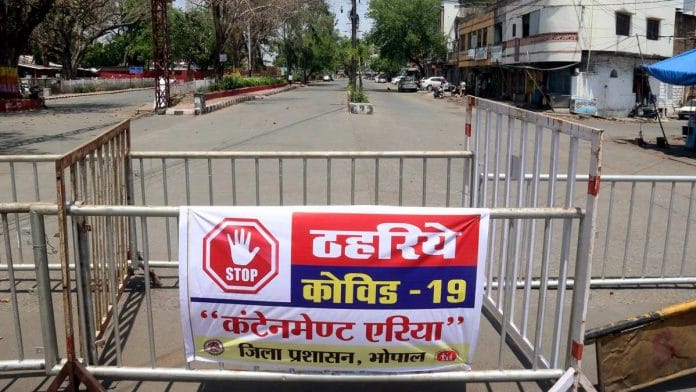Bhopal/Indore: There is an old Chinese saying which loosely translates as bad things never occur alone. This has been especially true of Madhya Pradesh, which since March had been left in lurch because of a ‘political coup’ and a raging pandemic. Kamal Nath resigned as CM on 20 March after 22 rebel Congress MLAs jumped ship to the BJP, the same day on which the state recorded its first Covid-19 case in Jabalpur.
In a month, two big hotspots emerged in the state — Indore and Bhopal. Questions were still being raised about the state government’s handling of the situation. Shivraj Singh Chouhan, who had been reinstated as the chief minister, did not appoint a Cabinet for nearly a month, which meant that he was also handling the home and health portfolios.
It was against this backdrop that ThePrint travelled a distance of over 800 kilometres to Indore and Bhopal. For the next two weeks we tried to understand how the government was controlling the burgeoning number of cases.
What we found was a state that was scrambling to gather all its resources to implement an extensive contact-tracing and containment exercise. From the first day of our visit in Indore, it became abundantly clear that this was coming a little late. It had already become difficult to identify how the first few cases had contracted the infection. There was now not a moment to be lost.
Also read: Has politics in Madhya Pradesh damaged its battle against coronavirus?
A major oversight in Indore
With 1,545 cases and 74 deaths, Indore, the most populous city of the state, has turned into a ghost town. Shut shops, empty streets apart from the occasional barricades and check posts is the only sight you see.
As we attempted to enter the city, on the night of the 12 April, we were let in with a lot of raised eyebrows and suspicion. The question in the eyes of the police officials was obvious: Why would anyone want to enter a city where a life-threatening disease was on the loose?
In the week that we spent in the hotspot city of MP, we came to realise that the city officials were making a brave effort to try and control the spread. Over a 100 doctors, dentists and paramedical staff were being deployed everyday to collect samples from different containment zones. The drastic increase in the number of cases was only expected. Men and women in white personal protective equipment had become a sight almost as common as the police personnel and were even being welcomed in neighbourhoods where they had earlier been treated with suspicion and even attacked.
On Day 1 of our visit, Chief Medical and Health Officer Praveen Jadia told ThePrint that no source had been identified in the first few cases — the index patients (the first few patients) didn’t have a travel history and there was no way of ascertaining who they had contracted it from.
The mystery unravelled at the hotspot areas we went to where we were told that the city had only implemented the lockdown nearly a week after PM Modi’s announcement, a major oversight for the commercial hub.
As the situation escalated, the state government was forced to call in former city SDM Manish Singh and DIG Harinath Chari Mishra. Singh, who was appointed as the District Collector, brought along with him a team of his 12 trusted officials.
Indore currently has about 200 containment areas or red zones, where a large number of positive cases have been recorded. The first few areas that were declared as containment zones were Khajrana, Tatpatti Bakhal, Ranipura and Bombay Bazaar — predominantly Muslim areas.
In an interaction with reporters, Manish Singh did not shy away from holding the community responsible for the spread. Even in an interview with ThePrint, he had said that a lot of members of this community tend to travel to places like Dubai. After the Tablighi Jamaat gathering in Delhi, it did not take long for the disease to get polarised and something similar can be seen in Indore too.
Muslims in the city live in large, crowded ghettos where social distancing is difficult. According to an ASHA worker ThePrint spoke to, the reason behind the community’s initial feeling of hostility towards the authorities was because the residents feared being picked up by police as some of these areas had been the hotbed of the anti-Citizenship Amendment Act and National Register of Citizens protests.
Things now seem to have settled as more and more people are being quarantined and discharged.
Broken administrative system in Bhopal
Bhopal presented a different scene. The lockdown was a little more lax — possibly owing to the fact that there were fewer cases here. There were more cars on the road, a few more people were seen walking around and it was definitely an easier task gaining access to the city.
The Covid-19 situation in the city had brought along a strange irony, but one that was telling of the broken administrative system. The first and its biggest hotspot had, in fact, been the state’s health department. And its epicentre was the one room, which had been designated as the Covid control room.
Through our conversations with various health officials we pieced together that the government had wholly been negligent of the social distancing guidelines, even failing to immediately quarantine those who had symptoms. Meetings of 40-50 people were being held within a small area with the bare minimum of precautions.
Several people ThePrint spoke to in the health department described this as the department’s arrogance. No one was held accountable and many of the officials have since returned to work after recovering. The incident had largely been hushed up and only spoken about it in whispers. Meanwhile, Chouhan in an interview blamed the Tablighi Jamaat for the rapid spread of Covid-19 in the state.
Also read: How MP’s health department office itself became Bhopal’s biggest Covid hotspot






